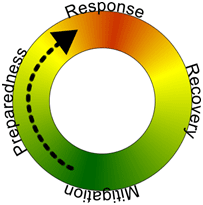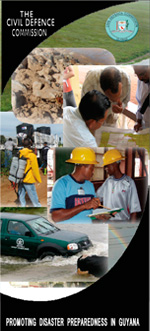A disaster is any event, natural or man-caused, which creates an intense negative impact on people, goods and services, and/or the environment, and exceeds the affected community’s internal capability to respond, prompting the need to seek outside assistance. One such example is the 2005 flood that affected Guyana.
The Comprehensive Disaster Management (CDM) Cycle
Guyana, through the CDC, has embarked on a Comprehensive Disaster Management (CDM) programme that illustrates the cyclic process by which we plan for and reduce the impact of disasters, taking steps to recover after a disaster has occurred. Appropriate actions at all points in the CDM cycle will lead to greater preparedness, better warnings, reduced vulnerability or the prevention of disasters during the next repetition of the cycle.
The figure below illustrates the four phases of the CDM cycle: Mitigation, Preparedness, Response andRecovery.
Phases of the CDM Cycle
There are four phases in the CDM cycle:
1. Mitigation:
During the mitigation phase structural and non-structural measures are undertaken to limit the adverse impact of natural and technological hazards, and environmental degradation. According the United Nations International Strategy for Disaster Reduction (UNISDR), the adverse impacts of hazards cannot often be fully prevented, but their scale or severity can be substantially reduced by various strategies and actions.
Management activities in the mitigation phase encompass engineering techniques and hazard-resistant construction, as well as improved environmental policies and public awareness, including hazard vulnerability and risk assessments.
Measures taken during the mitigation phase also address preventing natural or man-caused events from giving rise to disasters or any emergency situations, e.g. not allowing your child to have access to matches, gasoline, or kerosene oil.
2. Preparedness:
During the preparedness phase of the CDM cycle measures are taken to reduce the maximumlevel of loss in human life and other damage, through the organization of prompt and efficient actions of response and rehabilitation such as practicing earthquake or fire drills.
 Preparedness activities are geared towards minimizing disaster damage, enhancing disaster response operations and preparing organizations and individuals to respond. They also involve planning, organizing, training, interacting with other organizations and related agencies, resourcing inventory, allocating and placing, and plan testing.
Preparedness activities are geared towards minimizing disaster damage, enhancing disaster response operations and preparing organizations and individuals to respond. They also involve planning, organizing, training, interacting with other organizations and related agencies, resourcing inventory, allocating and placing, and plan testing.
3. Response:
Actions carried out in a disaster situation with the objective to save lives, alleviate suffering and reduce economic losses. The main tool in response to this is the implementation of plans which were prepared prior to the event.
Response activities are post activities geared towards:
• Providing emergency assistance
• Reducing the probability of additional injuries or damage
• Speeding recovery operations
• Returning systems to normal level
4. Recovery:
In the recovery phase, also referred to as the recovery and rehabilitation phase, activities are geared towards the restorating of basic services and the beginning of the repair of physical, social and economic damage e.g. livelines, health and communication facilities, as well as utility systems.
The recovery phase also includes efforts to reduce disaster risk factors.
Disaster Management encompasses all aspects of planning for and responding to disasters, including before, during, and after disaster activities. It refers to both the risk and consequences of a disaster.
Learn more about disasters in the caribbean.  Summary of Natural Disaster in the Caribbean (185.5 kB)
Summary of Natural Disaster in the Caribbean (185.5 kB)
